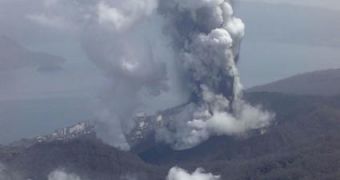Japan has about 200 volcanoes, of which 70 are active. The most famous Japanese volcano is Fujiyama. But this one erupted last time in 1707. Others are not that peaceful.
Usu, from the island of Hokkaido, has a bizarre behavior and look. At each eruption, the underground magma rises, forming amazing mounds, from a few tens to a few hundreds of meters tall, called cryptodomes. The cryptodomes form in the top of the volcano, in the middle of the fields and even inside human settlements. Unlike volcanic cones, made of the accumulation of products expelled though the mouth of the active volcanoes, the cryptodomes are made of old volcanic deposits, pushed up and deformed by the profound magma, which does not necessarily pierce to the surface. The Usu volcano experienced three eruptions of this type during the 20th century.
The first took place in 1910, creating 45 small open craters and a hill that grew like a mushroom to a height of 170 m (570 ft) in just several weeks.
The second eruption, in 1943-1945, formed the Showa-Shinzan ("The new mountain of the Showa Era"). The eruption started on 24th of December 1943, with quakes. To the end of February 1944, the ground had risen gradually in the middle of the fields in the eastern side of the volcano. Roads, houses and ditches in the area had cracked. The springs dried out just to emerge further away.
The center of the cambering, with a diameter of 4 km (2.5 mi) moved then close to the Fukaba village. To the middle of June, the soil had risen by 50 m (166 ft) and up to 250 quakes occurred daily. Fukaba was now on the top of a huge piston that kept on ascending.
On 23rd of June 1944, the explosions made of sand and mud started in a corn field, forming a crater with a diameter of 50 m (166 ft) that would remain active for 3 months. On the 2nd of July 1944, a terrible explosion projected 2 million tons of ash, causing the pulverization of the old rocks and damaging fields and forests. The inhabitants of Fukaba had to leave their homes. By October, the hill, baptized Showa-Shinzan, was 150 m (500 ft) tall. The deformation of the relief forced the displacement of the railway and the river nearby was turned into a reservoir.
At 1st of November, a hot dome at 1,000o C, with a diameter of 300 m (1,000 ft), made of viscous lava, pierced the dome and raised until September 1945, dominating by 110 m (366 ft) Showa Shinzan, being 300 m (1,000 ft) over the soil level in 1943. Today, about one million people visit the volcano annually.
The next eruption of Usu started on the 6th of August 1977. The previous forecasting quakes allowed the rapid evacuation of 65,000 people, inhabitants and visitors. Next day, the top of Usu projected enormous rock blocks and large amounts of ash. The explosion continued for 14 months (until October 1978), covering the neighboring fields and forests with a thick layer of dust. During the eruption, impressive soil movements, caused by lava motion, resulted in the deformation, raising and cracking of the volcano. The cracks stretched to the Toya Spa city, affecting most of the city and urban facilities: the hospital was split in two and the road experienced a 4 m (13 ft) displacement, being made sinuated. Over 200 houses and villas were destroyed, and also the cabin of the cable railway, leading to the top of Usu, turned useless because of the breakage of the cables and the displacement of the station on the top by 20 m (66 ft) from its initial location.
Even today, the northern side of Usu swells, in reprises of 3 cm (1.2 in) at intervals of 2 weeks. This is due to the pressure exerted by the magma. The large amounts of ash accumulated during the 1977-1978 eruption on the sides and the crater of Usu are drained during the rainfalls, causing dangerous mudslides. To impede their destructive action, large fences built around the volcano stop larger rock blocks and tree trunks.
Shock detectors trigger the alarm in the valley when successive mud slides occur, enabling the people to leave the area safely.

 14 DAY TRIAL //
14 DAY TRIAL //